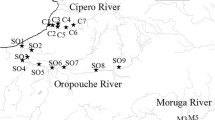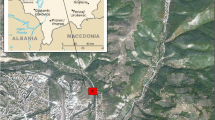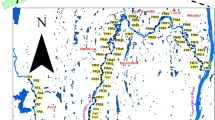Abstract
The To Lich River (TLR), which receives considerable amounts of wastewater from the inner city of Hanoi, is used for irrigation purposes by areas further downstream. The marked increase in urbanization in recent decades has meant that considerable amounts of untreated and/or partially treated wastewater from industry and households have been discharged into the river, causing serious environmental problems. Trace metal concentrations in surface waters and in different sediment layers were analyzed at nine sample sites along the TLR. The enrichment factor, geo-accumulation index (I geo), cluster analysis, and quality guidelines were used to assess the current status and potential risks arising from trace metal contamination. The Mn concentration in surface water exceeded the irrigation water standards at seven of the nine sites, and I geo values indicated that Cd was the most abundant trace metal in sediments at six of the nine sites. Sediments at all sites contained levels of trace metals that exceeded the maximum permissible concentrations of potentially toxic trace metals for crops, and all sediments were considered to be toxic to aquatic life. Cluster analysis revealed that TLR sediments could clearly be divided into three groups based on the degree of contamination. Accumulation of trace metals in sediments was in order of Cr > Cu > Ni > Zn > Pb > As > Mn.





Similar content being viewed by others
References
Anne M (1999) Distribution of heavy metals in recent sediments in the Archipelago Sea of southwestern Finland. Boreal Environ Res 4:319–330
Beg KR, Ali S (2008) Chemical contaminants and toxicity of Ganga River sediment from up and down stream Area at Kanpur. Am J Environ Sci 4:362–366
Bolt GH, Bruggenwert MGM (1976) Soil chemistry. Part A: Basic elements. Elsevier, Amsterdam
Bradley SB, Cox JJ (1986) Heavy metals in the Hamps and Manifold Valleys, North Staffordshire, UK: partitioning of metals in floodplain soils. Sci Total Environ 50:103–128
British Geological Survey (BGS) (2003) Water quality fact sheet: Manganese
Bunzl K, Schmidt W, Sanson B (1976) Kinetics of ion exchange in soil organic matter, IV, adsorption and desorption of Pb + 2, Cu + 2, Cd + 2, Zn + 2, and Ca + 2, by peat. J Soil Sci 27:32–41
Caliani JCF, Munoz FR, Dalan E (1997) Clay mineral and heavy metal distributions in the lower estuary of Huelva and adjacent Atlantic shelf, SW Spain. Sci Total Environ 198:181–200
Croue JP, Benedetti MF, Violleau D, Leenheer JA (2003) Characterization and copper binding of humic and nonhumic organic matter isolated from the South Platte River: evidence for the presence of nitrogenous binding site. Environ Sci Technol 37:328–336
Doan TT (2008) The foundation types in Hanoi and Ho Chi Minh City and assessment in terms of underground construction. In: Proceeding of International and Vietnamese Lessons Learnt on Urban Construction Work, Vietnam Federation of Civil Engineering Association. Hanoi. 22 October 2008
Dojlido JR, Taboryska B (1991) Exchange of heavy metals between sediment and water in the Wloclawek Reservoir on the Vistula River. In: Peters NE and Walling DE (eds) Sediment and Stream Water Quality in a Changing Environment: Trends and Explanation 203:315–321. International Association of Hydrological Sciences Press, Wallingford, Oxfordshire
Facetti J, Dekov VM, Grieken RV (1998) Heavy metals in sediments from the Paraguay River: a preliminary study. Sci Total Environ 209:79–86
Förstner U, Wittman GTW (1979) Metal pollution in the aquatic environment. Springer-Verlag, Berlin, Heidelberg, New York
Gabriela N, Juraj L, Ivan M (2010) Environmental aspect of manganese chemistry. Hung Electron J Sci ENV-100702-A
Gibbs RJ (1973) Mechanisms of trace metal transport in rivers. Science 180:71–73
González AE, Rodríguez MT, Sánchez JCJ, Espinosa AJF, Barragán De La Rosa FJ (2000) Assessment of metals in sediments in a tributary of Guadalquivir river (Spain). Heavy metal partitioning and relation between the water and sediment system. Water Air Soil Poll 121:11–29, 2000
Hanoi Environment and Natural Resources Department (HENRD) (2003) Environmental status of Hanoi City in 2002. Hanoi, Vietnam
Heiny JS, Tate CM (1997) Concentration, distribution, and comparison of selected trace elements in bed sediment and fish tissue in the South Platte River Basin, USA, 1992–1993. Arch Environ Contam Toxicol 32:246–259
Ho TLT, Egashira K (2000) Heavy metal characterization of river sediment in Hanoi, Vietnam. Comm Soil Sci Plant Anal 31:2901–2916
Horowitz AJ (1991) A primer on sediment-trace element chemistry. Lewis Publishers, Chelsea, Michigan
Hudson-Edwards K, Macklin M, Taylor M (1997) Historic metal mining inputs to Tees River sediment. Sci Total Environ 194:437–445
Jonasson I (1977) Geochemistry of sediment/water interactions of metals, including observations on availability. In: Shear H, Watson A (eds) The fluvial transport of sediment-associated nutrients and contaminants. IJC/PLUARG, Windsor, Ontario, pp 255–271
Kikuchi T, Furuichi T, Hai HT, Tanaka S (2009) Assessment of heavy metal pollution in river water of Hanoi, Vietnam using multivariate analyses. Bull Environ Contam Toxicol 83:575–582
Kiziloglu FM, Turan M, Sahin U, Kuslu Y, Dursun A (2008) Effects of untreated and treated wastewater irrigation on some chemical properties of cauliflower (Brassica olerecea L. var. botrytis) and red cabbage (Brassica olerecea L. var. rubra) grown on calcareous soil in Turkey. Agr Water Manage 95:716–724
Livens FR (1991) Chemical reactions of metals with humic material. Environ Pollut 70:183–208
Long ER, Field LJ, MacDonald DD (1998) Predicting toxicity in marine sediments with numerical sediment quality guidelines. Environ Toxicol Chem 17:714–727
Luoma SN (1983) Bioavailability of trace metals to aquatic organisms—A review. Sci Total Environ 28:1–22
MacDonald DD, Ingersoll CG, Berger TA (2000) Development and evaluation of consensus-based sediment quality guidelines for freshwater ecosystems. Arc Environ Contam Toxicol 39:20–31
Marshall CP, Fairbridge RW (1999) Encyclopedia of Geochemistry. Kluwer Academic, Dordrecht
Martin CW (2000) Heavy metal trends in floodplain sediments and valley fill, River Lahn, Germany. Catena 39:53–68
Maskell JE, Thornton I (1998) Chemical partitioning of heavy metals in soils, clays and rocks at historical lead smelting sites. Water Air Soil Pollut 108:391–409
Memet V, Bulent S (2012) Assessment of nutrient and heavy metal contamination in surface water and sediments of the upper Tigris River, Turkey. Catena 92:1–10
Mendez W (2005) Contamination of Rimac River Basin Peru, due to mining tailings. TRITALWR Master Thesis. Environmental Engineering and Sustainable Infrastructure, The Royal Institute of Technology (KTH), Stockholm
Middelkoop H, Thonon I, Perk MVD (2002) Effective discharge for heavy metal deposition on the lower River Rhine flood plains. In: Dyer FJ, Thorns MC, Olley JM (eds) The Structure, Function and Management of Fluvial Sedimentary Systems 276:151-159. International Association of Hydrological Sciences Press, Wallington, Oxfordshire
Mulligan CN, Yong RN (2006) Overview of natural attenuation of sediments. Contaminated sediments: evaluation and remediation techniques, STP 1482:210–222
Nguyen VC (2005) Establishing scientific basics for surface water supplement solution to improve river water quality in Hanoi City. HENRD scientific report. Hanoi Department of Science and Technology, Hanoi, Vietnam
Nguyen TLH, Ohtsubo M, Li L, Higashi T, Kanayama M (2008) Assessment of the water quality of two rivers in Hanoi City and its suitability for irrigation water. Paddy Water Environ 6:257–262
Nguyen TLH, Ohtsubo M, Li L, Higashi T, Kanayama M (2010) Heavy metal characterization and leachability of organic matter-rich river sediments in Hanoi, Vietnam. Int J Soil Sediment Water 3:1940–3259
Nriagu JO (1989) A global assessment of natural sources of atmospheric trace metals. Nature 338:47–49
Olivares-Rieumont S, de la Rosa D, Lima L, Graham DW, Alessandro DK, Borroto J, Martinez F, Sanchez J (2005) Assessment of heavy metal levels in Almendares River sediments—Havana City, Cuba. Water Res 39:3945–3953
Parthasarathy N, Pelletier M, Buffle J (2004) Permeation liquid membrane for trace metal speciation in natural waters—transport of liposoluble Cu(II) complexes. J Chromatogr A 1025:33–40
Pease P, Lecce S, Gares P, Rigsby C (2007) Heavy metal concentrations in sediment deposits on the Tar River floodplain following Hurricane Floyd. Environ Geol 51:1103–1111
Purves D (1985) Trace element contamination of the environment. Elsevier, Amsterdam
Rashid M (1974) Adsorption of metals on sedimentary and peat humic acids. Chem Geol 13:115–123
Rifaat AE (2005) Major controls of some metals distribution in sediments off the Nile Delta. Egypt. Egyptian J Aquatic Res 31:16–28
Salomons W, Förstner U (1984) Metals in the hydrocycle. Springer, Berlin
Saxby J (1969) Metal-organic chemistry of the geochemical cycle. Rev Pure Appl Chem 19:131–150
Sharma RK, Agrawal M, Marshall F (2007) Heavy metal contamination of soil and vegetables in suburban areas of Varanasi, India. Ecotoxicol Environ Saf 66:258–266
Simeonov V, Massart DL, Andreev G, Tsakovski S (2000) Assessment of metal pollution based on multivariate statistical modeling of “hot spot” sediments from the Black Sea. Chemosphere 41:1411–1417
Sin SN, Chua H, Lo W, Ng LM (2001) Assessment of heavy metal cations in sediments of Shing Mun River, Hong Kong. Environ Int 26:297–301
Singh AP, Ma LQ, Tack FMG, Verloo MG (2000) Trace metal leachability of land-disposed dredged sediments. J Environ Qual 29:1124–1132
Singh KP, Malik A, Sinha S, Singh VK, Murthy RC (2005) Estimation of source of heavy metal contamination in sediments of Gomti River (India) using principal component analysis. Water Air Soil Pollut 166:321–341
Singh A, Sharma RK, Agrawal M, Marshall FM (2010) Risk assessment of heavy metal toxicity through contaminated vegetables from waste water irrigated area of Varanasi, India. Trop Ecol 51(2S):375–387
Steve PM (1994) Effects of heavy metals from sewage sludge on soil microbes in agricultural ecosystems. In: Ross SM (ed) Toxic metals in soil-plant system. Wiley, Chichester, pp 247–274
Subramanian V, Grieken RV, Dack LV (1987) Heavy metal distribution in the sediments of Ganges and Brahmaputra Rivers. Environ Geol Water S 9:93–103
Sundaray SK, Nayak BB, Lin S, Bhatta D (2011) Geochemical speciation and risk assessment of heavy metals in the river estuarine sediments—a case study: mahanadi Basin, India. J Hazard Mater 186:1837–1846
Swanson V, Frist L, Rader R Jr, Huffman C Jr (1966) Metal sorption by northwest Florida humate. U.S. Geological Survey Professional Paper 550-C:174–177
Thuong NT, Yoneda M, Ikegami M, Takakura M (2013a) Source discrimination of heavy metals in sediment and water of To Lich River in Hanoi City using multivariate statistical approaches. Environ Monit Assess 185:8065–8075
Thuong NT, Yoneda M, Matsui Y (2013b) Does embankment improve quality of a river? A case study in To Lich River inner city Hanoi, with special reference to heavy metals. J Environ Prot 4:361–370
Turekian KK, Wedepohl KH (1961) Distribution of the elements in some major units of the earth’s crust. Geol Soc Am Bull 72:175–192
U.S. Environmental Protection Agency (USEPA) (2005) Partition coefficients for metals in surface water, soil and waste. USEPA, Office of Research and Development Washington, DC
U.S. Environmental Protection Agency (USEPA) (2006) National recommended water quality criteria. USEPA, office of water, Washington, DC
U.S. Environmental Protection Agency (USEPA) (2007) Method 3051A: Microwave assisted acid dissolution of sediments, sludges, soils, and oils. USEPA, Office of Solid Waste, Washington, DC
Vallius H (1999) Heavy metal deposition and variation in sedimentation rate within a sedimentary basin in central Gulf of Finland. Chemosphere 38:1959–1972
Varol M, Şen B (2009) Assessment of surface water quality using multivariate statistical techniques: a case study of Behrimaz Stream, Turkey. Environ Monit Assess 159:543–553
Ward JH (1963) Hierarchical grouping to optimize an objective function. J Am Stat Assoc 58:236–244
Woitke P, Wellmitz J, Helm D, Kube P, Lepom P, Litheraty P (2003) Analysis and assessment of heavy metal pollution in suspended solids and sediments of the river Danube. Chemosphere 51:633–642
World Health Organization (WHO) (2004) Manganese and its compounds: Environmental aspects
World Health Organization (WHO) (2006) Guidelines for the safe use of wastewater, excreta and greywater: Volume II: Wastewater Use in Agriculture
Yang Z, Wang Y, Shen Z, Niu J, Tang Z (2009) Distribution and speciation of heavy metals in sediments from the mainstream, tributaries, and lakes of the Yangtze River catchment of Wuhan, China. J Hazard Mater 166:1186–1194
Acknowledgments
Comments from the anonymous reviewers are gratefully acknowledged. This study was financially supported by Kyoto University, Global COE Program.
Author information
Authors and Affiliations
Corresponding author
Rights and permissions
About this article
Cite this article
Thuong, N.T., Yoneda, M., Shimada, Y. et al. Assessment of trace metal contamination and exchange between water and sediment systems in the To Lich River in inner Hanoi, Vietnam. Environ Earth Sci 73, 3925–3936 (2015). https://doi.org/10.1007/s12665-014-3678-7
Received:
Accepted:
Published:
Issue Date:
DOI: https://doi.org/10.1007/s12665-014-3678-7




